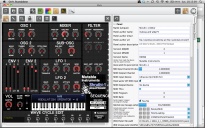http://www.mutable-instruments.net/shruthi1/build/delay
This filter boards combines a raw OTA-C 2-pole filter, combined with a classic lo-fi delay.
Using this filter board
Important! The Shruthi-1 control board needs to send specific digital control signals to drive this filter board.
Make sure that both the analog (CV1 to +5V) and digital (RX to +5V) ports of the filter and control boards are connected.
Make sure that the Shruthi-1 firmware v0.97 (or above) is installed, and that the fil (filter board) setting is set to dly on the system settings page.
The delay settings can be accessed by pressing the S2 switch (Filter page) a second time:
Tim lev fdb eq.
60 48 12 0
The delay parameters are the following:
tim (time): Delay time. The delay time is expressed in arbitrary units. Due to parts tolerance, the actual delay time might vary by a few percents, and this parameter is not accurately calibrated. The delay time typically ranges from 30ms (0) to 550ms (127). This parameter has a logarithmic scale, so the intermediate delay time (64) is close to 120ms.
lev (level): Delay level. This controls the wet signal level. No delay effect can be heard when this parameter is set to 0.
fdb (feedback): Delay feedback. This parameter controls the level of the signal taken at the output of the delay loop and fed back to the input.
eq. (fdbck. eq): Feedback tone color. A simple EQ circuit is present in the feedback loop. When this parameter is set to 0, the signal fed back into the delay is colored by a low-pass filter with a cutoff of 500 Hz. This causes the echoes to get darker and darker, an effect which is not unlike reverb with short delay times. When this parameter is set to 0, the signal fed back into the delay is colored by a high-pass filter with a cutoff of 500 Hz. This gives the echoes a “dub” flavor.
A few observations about the lo-fi-ness of the delay:
Using a longer delay time causes a degradation of the sound quality. Unlike traditional analog BBD delays, this degradation is not a bandwidth reduction, but rather a combination of a bandwidth reduction and the addition of quantization noise. This is due to the 1-bit sigma/delta conversion used in the PT2399.
The frequency response of the filter circuit in place around the PT2399 has a slight bump near 3kHz. This means that when feedback level is too high, a 3kHz tone will build up into the delay line. Whether this build-up is musically useful or annoying is up to you to decide, but we deliberately allowed this to occur. Thus, some combinations of the fdb and eq. parameter, particularly with eq. set to a high value and fdb greater than 10, will cause pathological feedback to occur.
In order to make quantization noise less audible when long delay times are used, the signal is heavily amplified in the mixer at the input of the delay line, with a soft-limiter in place to prevent clipping. Don’t be surprised if the echoes are more “fuzzy” than the original signal. This is particularly noticeable with high feedback times when many echoes add up to each other, causing the soft-limiter to get into action and add harmonics to the sound.



 .
.

